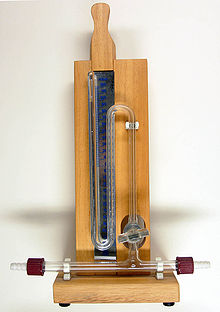Pressure
The Pressure calculator computes the pressure (P) from a force exerted on an area.  Pressure
Pressure
INSTRUCTIONS: Choose your preferred units and enter the following:
- (F) This is the force applied.
- (A) This is the area absorbing the force.
Pressure: The pressure (P) is returned in pascals. However, this can be automatically converted to other pressure units (e.g. inches of mercury) via the pull-down menu.
Related Calculators
- Compute force based on pressure and area
- Compute the area required to create a force based on pressure
- Compute Barometric pressure in the troposphere based on altitude
The Math / Science
This pressure exerted by some force on a object's surface applies to the pressures exerted by fluids also (liquids and gasses).
Pressure (symbol: p or P) is the ratio of force to the area over which that force is distributed.
Pressure is force per unit area applied in a direction perpendicular to the surface of an object. Gauge pressure (also spelled gage pressure) is the pressure relative to the local atmospheric or ambient pressure. Pressure is measured in any unit of force divided by any unit of area. The SI unit of pressure is the newton per square meter, which is called the pascal (Pa) after the seventeenth-century philosopher and scientist Blaise Pascal. The lbf/square inch (PSI) is the traditional unit of pressure in US/UK customary units. A pressure of 1 Pa approximately equals the pressure exerted by a dollar bill resting flat on a table. Everyday pressures are often stated in kilopascals (1 kPa = 1000 Pa) – 1 kPa is approximately one-seventh of a lbf/in2.  Barometer mercury column
Barometer mercury column
The formula for pressure is:
p = F/A
where:
- p is the pressure,
- F is the normal force,
- A is the area of the surface on contact.
Units
vCalc supports numerous units related to pressure including different units for pressure, area and force (See pull-down menus)
The SI unit for pressure is the pascal (Pa), equal to one newton per square metre (N/m2 or kg·m?1·s?2). This special name for the unit was added in 1971;[2] before that, pressure in SI was expressed simply in newtons per square metre.
Other units of pressure, such as pounds per square inch and bar, are also in common use. The CGS unit of pressure is the barye (ba), equal to 1 dyn·cm?2 or 0.1 Pa. Pressure is sometimes expressed in grams-force or kilograms-force per square centimetre (g/cm2 or kg/cm2) and the like without properly identifying the force units. But using the names kilogram, gram, kilogram-force, or gram-force (or their symbols) as units of force is expressly forbidden in SI. The technical atmosphere (symbol: at) is 1 kgf/cm2 (98.0665 kPa or 14.223 psi).
Since a system under pressure has potential to perform work on its surroundings, pressure is a measure of potential energy stored per unit volume. It is therefore related to energy density and may be measured in units such as joules per cubic metre.
Some meteorologists prefer the hectopascal (hPa) for atmospheric air pressure, which is equivalent to the older unit millibar (mbar). Similar pressures are given in kilopascals (kPa) in most other fields, where the hecto- prefix is rarely used. The inch of mercury is still used in the United States. Oceanographers usually measure underwater pressure in decibars (dbar) because pressure in the ocean increases by approximately one decibar per metre depth.
The standard atmosphere (atm) is an established constant. It is approximately equal to typical air pressure at earth mean sea level and is defined as 101325 Pa.
Because pressure is commonly measured by its ability to displace a column of liquid in a manometer, pressures are often expressed as a depth of a particular fluid (e.g., centimetres of water, millimetres of mercury or inches of mercury). The most common choices are mercury (Hg) and water; water is nontoxic and readily available, while mercury's high density allows a shorter column (and so a smaller manometer) to be used to measure a given pressure. The pressure exerted by a column of liquid of height h and density ? is given by the hydrostatic pressure equation p = ?gh. Fluid density and local gravity can vary from one reading to another depending on local factors, so the height of a fluid column does not define pressure precisely. When millimetres of mercury or inches of mercury are quoted today, these units are not based on a physical column of mercury; rather, they have been given precise definitions that can be expressed in terms of SI units.[citation needed] One millimetre of mercury is approximately equal to one torr. The water-based units still depend on the density of water, a measured, rather than defined, quantity. These manometric units are still encountered in many fields. Blood pressure is measured in millimetres of mercury in most of the world, and lung pressures in centimetres of water are still common.
Underwater divers use the metre sea water (msw or MSW) and foot sea water (fsw or FSW) units of pressure, and these are the standard units for pressure gauges used to measure pressure exposure in diving chambers and personal decompression computers. A msw is defined as 0.1 bar, and is not the same as a linear metre of depth, and 33.066 fsw = 1 atm.[3] Note that the pressure conversion from msw to fsw is different from the length conversion: 10 msw = 32.6336 fsw, while 10 m = 32.8083 ft
Gauge pressure is often given in units with 'g' appended, e.g. 'kPag', 'barg' or 'psig', and units for measurements of absolute pressure are sometimes given a suffix of 'a', to avoid confusion, for example 'kPaa', 'psia'. However, the US National Institute of Standards and Technology recommends that, to avoid confusion, any modifiers be instead applied to the quantity being measured rather than the unit of measure[4] For example, "pg = 100 psi" rather than "p = 100 psig".
Differential pressure is expressed in units with 'd' appended; this type of measurement is useful when considering sealing performance or whether a valve will open or close.
See Also
- Physics 105- Physics calculator
- Chemistry 101 - Chemistry calculator
- vector (3D) - vector calculator
References
- Wikipedia - http://en.wikipedia.org/wiki/Pressure
- Comments
- Attachments
- Stats
No comments |
